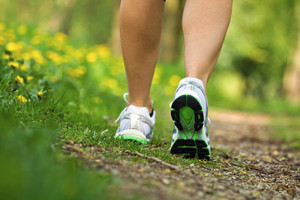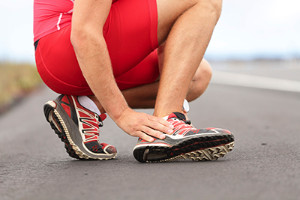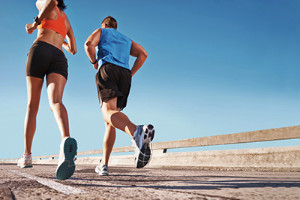Blog
Items filtered by date: July 2017
The Link Between Shock Absorption and Running Injuries
 A professor from Aix-Marseille University in France recently conducted a study in which she analyzed the mechanics of barefoot runners and runners who wore shoes. The results showed that barefoot runners were able to produce four times the amount of shock energy in their feet compared to those who ran in shoes. The significance behind this study helped researchers understand the effects of shock absorption in terms of preventing running injury. In regards to the study, University of Nevada professor John Mercer explains, “If you have too many impacts and the bone does not have a chance to recover, that can lead to a stress fracture or some other issue.”
A professor from Aix-Marseille University in France recently conducted a study in which she analyzed the mechanics of barefoot runners and runners who wore shoes. The results showed that barefoot runners were able to produce four times the amount of shock energy in their feet compared to those who ran in shoes. The significance behind this study helped researchers understand the effects of shock absorption in terms of preventing running injury. In regards to the study, University of Nevada professor John Mercer explains, “If you have too many impacts and the bone does not have a chance to recover, that can lead to a stress fracture or some other issue.”
If you have any concerns about your feet, contact Dr. Rosa Roman from Ankle and Foot Center. Our doctor can provide the care you need to keep you pain-free and on your feet.
Biomechanics in Podiatry
Podiatric biomechanics is a particular sector of specialty podiatry with licensed practitioners who are trained to diagnose and treat conditions affecting the foot, ankle and lower leg. Biomechanics deals with the forces that act against the body, causing an interference with the biological structures. It focuses on the movement of the ankle, the foot and the forces that interact with them.
A History of Biomechanics
- Biomechanics dates back to the BC era in Egypt where evidence of professional foot care has been recorded.
- In 1974, biomechanics gained a higher profile from the studies of Merton Root, who claimed that by changing or controlling the forces between the ankle and the foot, corrections or conditions could be implemented to gain strength and coordination in the area.
Modern technological improvements are based on past theories and therapeutic processes that provide a better understanding of podiatric concepts for biomechanics. Computers can provide accurate information about the forces and patterns of the feet and lower legs.
Understanding biomechanics of the feet can help improve and eliminate pain, stopping further stress to the foot.
If you have any questions please feel free to contact our office located in Bloomfield, NJ . We offer the newest diagnostic and treatment technologies for all your foot and ankle needs.
Read more about The Importance of Biomechanics in PodiatryDealing with Plantar Fasciitis
 Plantar fasciitis occurs when the tough band of tissue along the base of the foot (plantar fascia) becomes inflamed. The condition itself can be caused by a variety of reasons; the most common being having flat feet, exercising too much, being overweight, or wearing improper footwear. Most people with plantar fasciitis experience pain in the morning that usually goes away as the day progresses. It is a tricky condition to treat because not all cases are the exact same. A treatment that works for one person may not necessarily work for others. However, resting the feet often allows the plantar fasciitis to repair itself over time.
Plantar fasciitis occurs when the tough band of tissue along the base of the foot (plantar fascia) becomes inflamed. The condition itself can be caused by a variety of reasons; the most common being having flat feet, exercising too much, being overweight, or wearing improper footwear. Most people with plantar fasciitis experience pain in the morning that usually goes away as the day progresses. It is a tricky condition to treat because not all cases are the exact same. A treatment that works for one person may not necessarily work for others. However, resting the feet often allows the plantar fasciitis to repair itself over time.
Plantar warts can be very uncomfortable. If you need your feet checked, contact Dr. Rosa Roman from Ankle and Foot Center. Our doctor will assist you with all of your foot and ankle needs.
About Plantar Warts
Plantar warts are the result of HPV, or human papillomavirus, getting into open wounds on the feet. They are mostly found on the heels or balls of the feet.
While plantar warts are generally harmless, those experiencing excessive pain or those suffering from diabetes or a compromised immune system require immediate medical care. Plantar warts are easily diagnosed, usually through scraping off a bit of rough skin or by getting a biopsy.
Symptoms
- Lesions on the bottom of your feet, usually rough and grainy
- Hard or thick callused spots
- Wart seeds, which are small clotted blood vessels that look like little black spots
- Pain, discomfort, or tenderness of your feet when walking or standing
Treatment
- Freezing
- Electric tool removal
- Laser Treatment
- Topical Creams (prescription only)
- Over-the-counter medications
To help prevent developing plantar warts, avoid walking barefoot over abrasive surfaces that can cause cuts or wounds for HPV to get into. Avoiding direct contact with other warts, as well as not picking or rubbing existing warts, can help prevent the further spread of plantar warts. However, if you think you have developed plantar warts, speak to your podiatrist. He or she can diagnose the warts on your feet and recommend the appropriate treatment options.
If you have any questions please feel free to contact our office located in Bloomfield, NJ . We offer the newest diagnostic and treatment technologies for all your foot and ankle needs.
Ways to Avoid Injury While Running
 Injuries can be a major setback for people who love to run, so it is important that you take preventative measures in order to avoid them. One of the most vital tips for avoiding injury is to ease your way into any new routine. Jumping into more than you can handle is a common cause of injury for runners. Another tip is to buy appropriate shoes for your running workout. There are major differences between shoes that are built for walking, running, and cross-training; it is crucial that you choose footwear that is most suitable for your routine. Resting is also important so that you do not overwork your body. The human body isn’t built to do high-intensity workouts every day, so you should incorporate rest days into your schedule. Lastly, stretching is essential to every running routine. Always stretch before and after a run.
Injuries can be a major setback for people who love to run, so it is important that you take preventative measures in order to avoid them. One of the most vital tips for avoiding injury is to ease your way into any new routine. Jumping into more than you can handle is a common cause of injury for runners. Another tip is to buy appropriate shoes for your running workout. There are major differences between shoes that are built for walking, running, and cross-training; it is crucial that you choose footwear that is most suitable for your routine. Resting is also important so that you do not overwork your body. The human body isn’t built to do high-intensity workouts every day, so you should incorporate rest days into your schedule. Lastly, stretching is essential to every running routine. Always stretch before and after a run.
Exercising your feet regularly with the proper foot wear is a great way to prevent injuries. If you have any concerns about your feet, contact Dr. Rosa Roman of Ankle and Foot Center. Our doctor will treat your foot and ankle needs.
How to Prevent Running Injuries
Many common running injuries are caused by overuse and overtraining. When the back of the kneecap starts wearing out and starts causing pain in your knee, this is commonly referred to as runner’s knee. Runner’s knee is a decrease in strength in your quadriceps and can occur if you’re not wearing properly fitted or supporting shoes. To prevent runner’s knee, focusing on hip strengthening is a good idea, as well as strengthening your quads to keep the kneecaps aligned.
What Are Some Causes of Running Injuries?
- One cause of a common running injury is called iliotibial band syndrome.
- Plantar fasciitis is also another common injury.
- Stress fractures can occur from overtraining, lack of calcium, or even your running style.
Best Ways to Prevent Running Injuries
- Wear footwear that fits properly and suits your running needs.
- Running shoes are the only protective gear that runners have to safeguard them from injury.
- Make a training schedule. Adding strengthening exercises as well as regular stretching can help keep you strong and limber and can lessen the possibility of injuries.
- Stretching keeps muscles limber; this will help you gain better flexibility.
If you have any questions please feel free to contact our office located in Bloomfield, NJ . We offer the newest diagnostic and treatment technologies for all your foot and ankle needs.
Read more about How to Prevent Running InjuriesTips for Healthy Feet
 Some of the most common complaints people have with their feet are pain, ingrown toenails, cracked heels, and fungus. When it comes to foot pain, many people are unaware that flat shoes can be just as bad as high heels. Flats do not offer any support for the foot, which can cause those who wear them to experience a lot of pain. Ingrown toenails are often the result of cutting your nails incorrectly; instead of cutting your nails in a rounded shape, you should cut them straight across. If you are trying to cure your cracked heels, you should know that they are caused by a lack of moisture in the feet. A helpful tip is to always moisturize and treat your feet the same way you would want to treat the skin on your face. If you want to get rid of toenail fungus, you should always treat it in its early stages, instead of letting it progress into something much worse. If you have any questions about any of these common foot issues, you should speak to a podiatrist right away.
Some of the most common complaints people have with their feet are pain, ingrown toenails, cracked heels, and fungus. When it comes to foot pain, many people are unaware that flat shoes can be just as bad as high heels. Flats do not offer any support for the foot, which can cause those who wear them to experience a lot of pain. Ingrown toenails are often the result of cutting your nails incorrectly; instead of cutting your nails in a rounded shape, you should cut them straight across. If you are trying to cure your cracked heels, you should know that they are caused by a lack of moisture in the feet. A helpful tip is to always moisturize and treat your feet the same way you would want to treat the skin on your face. If you want to get rid of toenail fungus, you should always treat it in its early stages, instead of letting it progress into something much worse. If you have any questions about any of these common foot issues, you should speak to a podiatrist right away.
Everyday foot care is very important to prevent infection and other foot ailments. If you need your feet checked, contact Dr. Rosa Roman from Ankle and Foot Center. Our doctor can provide the care you need to keep you pain-free and on your feet.
Everyday Foot Care
Often, people take care of their bodies, face and hair more so than they do for their feet. But the feet are a very important aspect of our bodies, and one that we should pay more attention to. Without our feet, we would not be able to perform most daily tasks.
It is best to check your feet regularly to make sure there are no new bruises or cuts that you may not have noticed before. For dry feet, moisturizer can easily be a remedy and can be applied as often as necessary to the affected areas. Wearing shoes that fit well can also help you maintain good foot health, as well as making it easier to walk and do daily activities without the stress or pain of ill-fitting shoes, high heels, or even flip flops. Wearing clean socks with closed shoes is important to ensure that sweat and bacteria do not accumulate within the shoe. Clean socks help to prevent Athlete’s foot, fungi problems, bad odors, and can absorb sweat.
If you have any questions please feel free to contact our office located in Bloomfield, NJ . We offer the newest diagnostic and treatment technologies for all your foot and ankle needs.
Blog Archives
- April 2025
- March 2025
- February 2025
- January 2025
- December 2024
- November 2024
- October 2024
- September 2024
- August 2024
- July 2024
- June 2024
- May 2024
- April 2024
- March 2024
- February 2024
- January 2024
- December 2023
- November 2023
- October 2023
- September 2023
- August 2023
- July 2023
- June 2023
- May 2023
- April 2023
- March 2023
- February 2023
- January 2023
- December 2022
- November 2022
- October 2022
- September 2022
- August 2022
- July 2022
- June 2022
- May 2022
- April 2022
- March 2022
- February 2022
- January 2022
- December 2021
- November 2021
- October 2021
- September 2021
- August 2021
- July 2021
- June 2021
- May 2021
- April 2021
- March 2021
- February 2021
- January 2021
- December 2020
- November 2020
- October 2020
- September 2020
- August 2020
- July 2020
- June 2020
- May 2020
- April 2020
- March 2020
- February 2020
- January 2020
- December 2019
- November 2019
- October 2019
- September 2019
- August 2019
- July 2019
- June 2019
- May 2019
- April 2019
- March 2019
- February 2019
- January 2019
- December 2018
- November 2018
- October 2018
- September 2018
- August 2018
- July 2018
- June 2018
- May 2018
- April 2018
- March 2018
- February 2018
- January 2018
- December 2017
- November 2017
- October 2017
- September 2017
- August 2017
- July 2017
- June 2017
- May 2017
- April 2017
- March 2017
- February 2017
- January 2017
- December 2016
- November 2016
- October 2016
- September 2016
- August 2016
- July 2016
- June 2016
- May 2016
- April 2016
